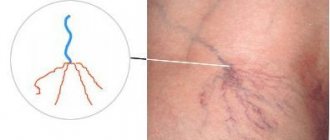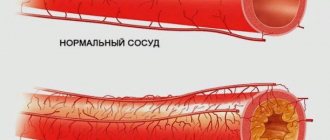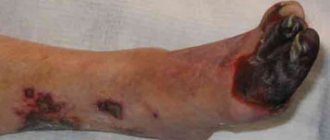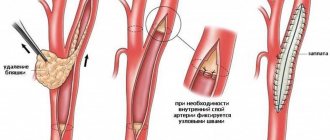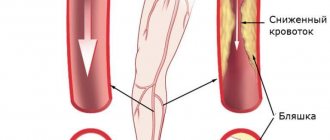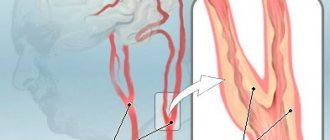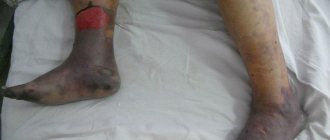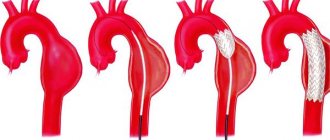The largest arterial vessel in the human body is the aorta. It originates from the left ventricle of the heart, runs along the spine and supplies oxygenated blood to all organs and tissues.
Damage to the aorta occurs as a result of a violation of cholesterol metabolism in the body. At the same time, low and very low density cholesterol accumulates in the endothelium of the vessel, which leads to the proliferation of connective tissue in its wall and a decrease in elasticity. Further development of the pathology causes the formation of an atherosclerotic plaque, which constantly increases in size and reduces the patency of the artery. Violation of the integrity of the plaque leads to its instability, accumulation of platelets on the surface of the formation, which significantly reduces the lumen of the vessel and slows down blood circulation.
Aortic sclerosis can develop anywhere and occurs as a result of the formation of an atherosclerotic plaque consisting of cholesterol, fats and calcium in the vessel wall. The disease develops after the age of 40, and the male population is affected more often than the female population.
Why is atherosclerosis of the aorta really dangerous?
The aorta is a vessel on which the blood supply and nutrition of almost all vital organs depends. From the thoracic region, where the aorta begins, leaving the heart, its branches go to the organs of the chest and the brain. From the abdominal region, where the aorta descends, branches supply all the abdominal organs, kidneys, pelvis and lower limbs. If the lumen of the aorta in the thoracic or abdominal region narrows or, worse, becomes clogged, a deficiency of blood supply develops in certain organs associated with the aorta, which can lead to life-threatening complications in all organs and systems. Did you know that...
- Most often, people over 60 years of age suffer from atherosclerosis of the aorta and its branches, but you can also get sick at a young age
- Sometimes the initial signs of aortic atherosclerosis are detected even in children 10-12 years old: this suggests that this disease can develop for decades without showing itself in any way
- The risk of developing aortic atherosclerosis is approximately twice as high if you are over 40, smoke, drink alcohol, are sedentary, and consume unhealthy foods such as fast food
- No one is immune from atherosclerosis: even if you have been taking care of your health since childhood and feel great, it is not a fact that you do not have this disease
Remember: to find out for sure how healthy your blood vessels are, contact our specialists who will conduct an accurate diagnosis and assess your risks. Sign up now.
Clinical picture
Symptoms of the disease depend on the level of damage to the aorta, which is divided into the thoracic and abdominal parts. The thoracic section of a large artery supplies blood to the brain, heart, lungs, and upper limbs. Vascular branches from the abdominal part supply blood to the kidneys, abdominal and pelvic organs, and lower extremities. In severe cases of sclerosis, the entire length of the aorta may be affected, which is manifested by the diversity of the clinical course of the disease.
The disease includes several stages:
- Preclinical period – changes are observed with laboratory and instrumental research methods.
- Period of clinical manifestations – symptoms of the disease are revealed, depending on the level of vascular pathology.
Stages of development of aortic atherosclerosis
- Ischemic – manifested by attacks of angina, claudication, abdominal pain, increased blood pressure
- Thrombonecrotic – stage of life-threatening complications, including myocardial infarction, stroke, gangrene, renal failure and others
- Fibrous - when the disease develops over a long period of time, fibrous tissue replaces other types of tissue and disrupts the normal functioning of the relevant organs
Please note: symptoms of aortic atherosclerosis begin to appear when the disease progresses and ischemia (lack of blood supply) develops in one of the areas of the blood supply to the organ.
Damage to the abdominal part of the artery
Sclerosis of the abdominal aorta leads to disruption of the blood supply to the abdominal organs (intestines, liver, stomach), retroperitoneal space (kidneys), and pelvic organs (uterus, gonads, bladder). The disease can also cause the development of an abdominal form of myocardial infarction. The development of pathology at the level of the artery bifurcation leads to a decrease in blood flow in the lower extremities and the occurrence of trophic disorders in them.
Sclerotic lesions of the vessels of the legs lead to the formation of trophic disorders
Clinical manifestations of sclerotic aorta in the abdominal part:
- aching pain in the abdomen of an incoming nature;
- tendency to constipation, flatulence;
- loss of appetite, weight loss;
- coldness of the lower extremities, decreased sensitivity, numbness;
- intermittent claudication syndrome (pain in the legs when moving);
- swelling of the lower extremities, trophic ulcers;
- decreased tone of the calf muscles;
- sexual impotence in men.
Changes in the aorta can be detected by palpation (feeling) through the abdominal wall in the form of compaction and curvature of its wall. In severe cases, there is no pulsation at the level of the navel, in the groin and popliteal areas, or on the vessels of the feet. Thrombosis of the mesenteric arteries is considered a dangerous complication of aortic atherosclerosis, which is accompanied by intense abdominal pain; the attack is not controlled by analgesics and leads to the development of sepsis.
Signs of atherosclerosis of the aorta: thoracic region
- Severe chest pain (aortalgia) - lasts several hours and even days, the pain is burning, pressing, radiates to the left and right arm, shoulder, neck, spine, interscapular area, while nitroglycerin does not help
- Heart failure with attacks of suffocation - occurs because the affected aorta increases the load on the heart
- Increased blood pressure
- Difficulty swallowing, hoarseness of voice
- Retrosternal attacks of angina - pain radiates to the left arm and left half of the chest
- Shortness of breath and palpitations
- Dizziness, short-term fainting, pallor of the face, headaches with high blood pressure, memory impairment, increased fatigue, pulsation between the ribs to the right of the sternum, convulsions when turning the head - all these symptoms are caused by a lack of blood supply to the brain
Damage to the thoracic artery
The aortic root is located at the exit of the left ventricle in close proximity to the semilunar valve. Its atherosclerotic changes cause vasoconstriction, which leads to increased pressure in the left side of the heart and pulmonary circulation. The semilunar valve changes as a result of changes in hemodynamics (blood movement), and its insufficiency develops.
Damage to the aortic root leads to semilunar (aortic) valve insufficiency
When the pathological process is advanced, an insufficient amount of blood enters the systemic circulation, which stagnates in the lungs. This leads to pneumosclerosis (replacement of lung tissue with fibrous tissue), impairs the enrichment of blood with oxygen, and causes the development of organ hypoxia (insufficient oxygen supply). Increasing hypertrophy of the left ventricle compresses the coronary arteries and leads to ischemic damage to the heart, leading to myocardial infarction.
Three large arterial vessels branch from the aortic arch: the brachiocephalic trunk, the left common carotid and the subclavian artery. They supply blood to the neck, upper limbs, head, including the brain. The most severe is damage to the blood vessels of the brain, which can result in the development of hemorrhagic and ischemic strokes.
Clinical manifestations of aortic sclerosis in the thoracic part:
- pressing pain behind the sternum, spreading to the neck, arms, epigastrium, interscapular area;
- hoarseness of voice, difficulty swallowing (with damage to the arterial arch);
- an increase in systolic (upper) blood pressure, while diastolic (lower) remains within normal limits;
- headaches and dizziness, fainting;
- convulsions with a sudden change in body position;
- pulsation in the intercostal area of the right half of the chest;
- formation of wen on the face and neck, change in the color of the iris (trophic disorders).
The disease is characterized by a long asymptomatic course and is often diagnosed at the stage of development of severe complications such as myocardial infarction and cerebral stroke.
Atherosclerosis of the abdominal aorta: symptoms
Atherosclerosis of the abdominal aorta disrupts the blood supply to the internal organs and lower extremities, which is why the symptoms can be very diverse:
- Pain in the navel area is an intermittent “wandering” character, accompanied by bloating and constipation
- Increased blood pressure as a result of renal ischemia
- Weight loss – occurs due to disturbances in the digestive system
- No pulsation in the navel area, under the knees and on the back of the feet
- Problems with sexual life in men, infertility
- Pain in calves when walking that goes away when you stop
- Intermittent lameness
- Numb feet
- Cold feet
- Swelling and redness of the legs and feet
- Necrotic ulcers on the skin of the legs - occur in the last stages of the disease
Remember: aortic atherosclerosis is a dangerous disease that can develop for years without symptoms. If symptoms appear, it means that the disease is progressing and can at any time lead to complications that could cost you your life.
Therefore, do not delay your visit to the doctor. Make an appointment now.
Atherosclerosis of the aorta: complications
As a rule, complications with aortic atherosclerosis develop if the disease is left untreated for years or treated incorrectly.
- Intestinal gangrene, which occurs when blood access through the mesenteric artery is cut off: manifests itself as severe abdominal pain, tension in the abdominal muscles, and increasing intoxication
- Thrombosis of the superior mesenteric artery - profuse vomiting and profuse feces
- Thrombosis of the inferior mesenteric artery – intestinal obstruction and rectal bleeding
- Gangrene of the legs due to thrombosis of the femoral artery
- Thoracic or abdominal aneurysm - acute bleeding that can quickly lead to death
And a number of other life-threatening complications that can lead to death.
Atherosclerosis of the aorta: risk factors
There are many factors influencing the development of atherosclerosis. Let's talk about the main ones.
Factors that cannot be eliminated:
- Age. The older you get, the higher your risk of developing atherosclerosis of the aorta. If you are over 50, diagnosis is vital – even if there are no symptoms
- Floor. Men suffer from atherosclerosis in general and atherosclerosis of the aorta 4 times more often than women. After 55 years, the risk of the disease in both sexes is equalized, since in women the level of sex hormones - estrogens, which, according to scientists, has a beneficial effect on the condition and functioning of blood vessels, decreases
- Heredity. If one of your close relatives has had or is suffering from aortic atherosclerosis, your risk of developing this disease is much higher
Avoidable factors:
- Smoking and alcohol. Nicotine and other harmful substances contained in tobacco smoke, as well as alcohol, provoke vascular spasms, which increases the risk of narrowing the lumen significantly.
- Poor nutrition. If your diet contains too much animal fat, your risk of developing atherosclerosis is higher, as it accelerates atherosclerotic changes in blood vessels.
- Sedentary lifestyle. It provokes fat imbalance, which is one of the main causes of cholesterol deposits on the walls of blood vessels.
Partially avoidable factors:
- Arterial hypertension. High blood pressure increases damage to the vascular wall, followed by the deposition of cholesterol in it and the formation of atherosclerotic plaques
- Dyslipidemia. Impaired fat metabolism is accompanied by an increase in the level of low and very low density lipoproteins (“bad cholesterol”), which accelerates the development of atherosclerosis
- Diabetes and obesity. If you are obese or diabetic, or worse, both, your risk of developing arteriosclerosis is 5-7 times higher
- Intoxication, infections. Toxic substances and infections damage the walls of blood vessels, which accelerates the development of atherosclerotic changes
Causes of pathology and risk factors
Atherosclerosis of the aorta does not occur out of nowhere. A number of unfavorable factors affecting the human body lead to its occurrence. Some of them are irreparable, while others can be partially or completely eliminated.
Unavoidable factors include:
- gender (men are more susceptible to atherosclerosis than the fairer sex);
- hereditary predisposition;
- age-related characteristics of the body (most often, severe atherosclerotic damage to the main artery and other parts of the vascular bed occurs in people over 60 years of age).
Risk factors leading to the occurrence of atherosclerosis of the aortic arch and its branches, atherosclerosis of the aortic root, which can be eliminated, include: extra pounds, the presence of addictions, lack of cardio, excessive levels of lipids in the diet, exposure to frequent stress.
Partially removable causes are: impaired carbohydrate metabolism (type 2 diabetes mellitus), hypertension. Timely lifestyle changes have a positive effect on the outcome of the disease!
Atherosclerosis of the aorta: diagnosis
Diagnosis begins with a consultation. Our specialist will spend as much time as necessary for you to collect all the necessary information: what exactly are you complaining about, whether you have concomitant diseases, whether any of your close relatives have suffered or are suffering from atherosclerosis or other diseases of the cardiovascular system. A general examination, which the doctor will conduct at the appointment, will help to identify or exclude various signs of atherosclerotic vascular damage, for example, edema, trophic ulcers, weight loss or gain and a number of other signs. Auscultation (listening) of the vessels of the heart and aorta will help to identify or exclude murmurs, disturbances in arterial pulsation and other indicators. A blood test will help determine the level of cholesterol, low-density lipoproteins, and triglycerides. Doppler ultrasound will reveal signs of aortic atherosclerosis: its thickening, expansion in the abdominal or thoracic regions, aneurysms, calcification. Ultrasound scanning of the renal vessels will reveal or exclude the presence of plaques in the renal arteries. Ultrasound scanning of the vessels of the lower extremities, aorta, and carotid arteries will help determine how much the main blood flow in them is reduced, as well as identify atheromatous plaques and blood clots in the lumens of the vessels. If necessary, your doctor will refer you for a coronary angiography, which will help accurately assess the condition of the coronary arteries. Please note: only such a comprehensive diagnosis will help make an accurate diagnosis, assess the extent of vascular damage and select the optimal treatment that will really help you. Make an appointment now.
Reasons for the development of the disease
Factors contributing to aortic sclerosis include:
- increased levels of low and very low density cholesterol and triglycerides in the blood;
- decreased glucose tolerance;
- diabetes;
- hypertension, symptomatic hypertension;
- metabolic disorders (gout);
- physical inactivity (sedentary lifestyle);
- chronic stress;
- obesity;
- nicotine and alcohol addiction;
- hereditary predisposition.
Narrowing of a vessel by an atherosclerotic plaque causes hypoxia of the organ to which it supplies blood.
An important role in the development of sclerotic changes in the arteries is played by poor nutrition. The predominance in food of fatty foods high in cholesterol, easily digestible carbohydrates and a lack of vitamins leads to the appearance of pathology.
Drug treatment of aortic atherosclerosis
Drug treatment of aortic atherosclerosis includes several groups of drugs. Let's discuss the main ones.
- Nicotinic acid and its derivatives Reduce the level of triglycerides and cholesterol in the blood. They increase the level of high-density lipoproteins, which have antiatherogenic properties. Contraindicated for liver disease: if you have any, your doctor will select another medicine.
- Fibrates (miscleron, gevilan, atromide) Reduce the synthesis of your own fats, but can adversely affect liver function and provoke cholelithiasis. Statins (Zocor, Mevacor, Liprimar) Reduce the amount of “bad” cholesterol produced by the liver and, as a result, reduce its level in the blood. Statins are taken at night because cholesterol is synthesized, as a rule, at night.
- Bile acid sequestrants (cholestide, cholestyramine) Bind and remove bile acids, reduce the level of cholesterol and fats in the body. May cause constipation and flatulence.
Preventive measures
To get rid of the disease, a diet is used that can restore metabolism, normalize blood pressure, and improve the body's tolerance to glucose. The basic principles of proper nutrition include:
- reducing the calorie content of food to 2000 kcal/day to combat excess weight;
- reducing the content of animal fats in the diet (pork, butter, lard) to normalize high-density lipoproteins in the blood;
- eliminating the intake of “wrong” carbohydrates (baked goods, sweets, potatoes, rice) to normalize the process of glucose tolerance and the conversion of these products into fats;
- reducing salt intake to restore normal blood pressure levels;
- eating fiber (cabbage, vegetables, fruits) and foods with a high concentration of polyunsaturated fats (vegetable oil, seafood) to normalize blood cholesterol.
Physical exercise, walking, and giving up bad habits are useful, which significantly improves your health. Breathing exercises are indicated for the appearance of pneumosclerosis.
Surgical treatment of aortic atherosclerosis
Surgeries are prescribed when drug therapy does not help. Our specialists will determine how much surgery you need and which method of surgical intervention will be effective in your case. Possible methods may include:
- Stenting The surgeon will install a special stent into the lumen of the vessels, which will expand the narrowed area and ensure free blood flow
- Bypass surgery The surgeon will install a shunt to bypass the narrowed area, as a result of which blood flow through the affected vessel will be restored
- Plastic surgery of a segment of the aorta or its branches with an endoprosthesis
Complications
The consequences of atherosclerotic lesions of the aorta include such dangerous conditions as dissecting aortic aneurysms, renal failure, and stroke.
- Aneurysms are considered one of the most serious complications of atherosclerosis. Enlarged areas appear due to weakening of the vascular wall. The danger of an aneurysm of the abdominal aorta or its thoracic region is the rupture and dissection of the artery, as a result of which the patient risks dying on the way to the hospital. We wrote more about the treatment of abdominal aortic aneurysm here.
- The formation of blood clots in the aortic arch leads to cerebral ischemia and stroke.
- A complication of damage to the buffering zone is the development of necrosis of leg tissue, as well as with obliterating atherosclerosis of the lower extremities. This leads to limb amputation and disability.
Atherosclerosis of the aorta: prevention
Proper prevention is one of the key conditions for successful recovery, which cannot be neglected:
- Stop smoking and drinking alcohol
- Avoid foods and dishes containing animal fats
- Treat concomitant diseases in a timely manner if you have them: diabetes mellitus, arterial hypertension, obesity
- Lead an active lifestyle, move more, play sports, but do not overwork your body
- Don't be nervous about trifles
- Cure infectious diseases in a timely manner
- Get annual checkups and examinations, especially if you are over 40 years old
Diet for atherosclerosis of the aorta
Despite the fact that the proportion of cholesterol that we get from food is not very large (up to 25%), proper nutrition in combination with the right treatment and a healthy lifestyle will significantly increase the effectiveness of treatment.
Products we recommend excluding:
- Sour cream
- Mayonnaise
- Sauces
- Chips
- Salted nuts
- Cocoa and chocolate
- White butter bread
- Baked goods, biscuits, cakes, pastries
- Butter and sour creams
- Puddings and ice cream
- Cheese, margarine, dairy products
- Whole milk
- Coconut and palm oil
- Suet
- Butter, animal fats
- Pates, hams, smoked sausages
- Fat duck or goose
- By-products (brains, kidneys, liver)
- Fatty meat (pork, lamb, beef)
Foods that will help lower cholesterol levels:
- Green salads
- Garlic
- Onion
- Dill
- Parsley
- Legumes
- Fruits
- Lean meat
- Shellfish
- Wholemeal flour
- Oat groats
- Bran
- Fatty sea fish (herring, mackerel, sardines, salmon, tuna)
- Vegetable oils
Remember: the earlier aortic atherosclerosis is detected, the higher the chance of stopping the progression of this disease and preventing life-threatening complications. Therefore, do not delay your visit to the doctor. Make an appointment now.
